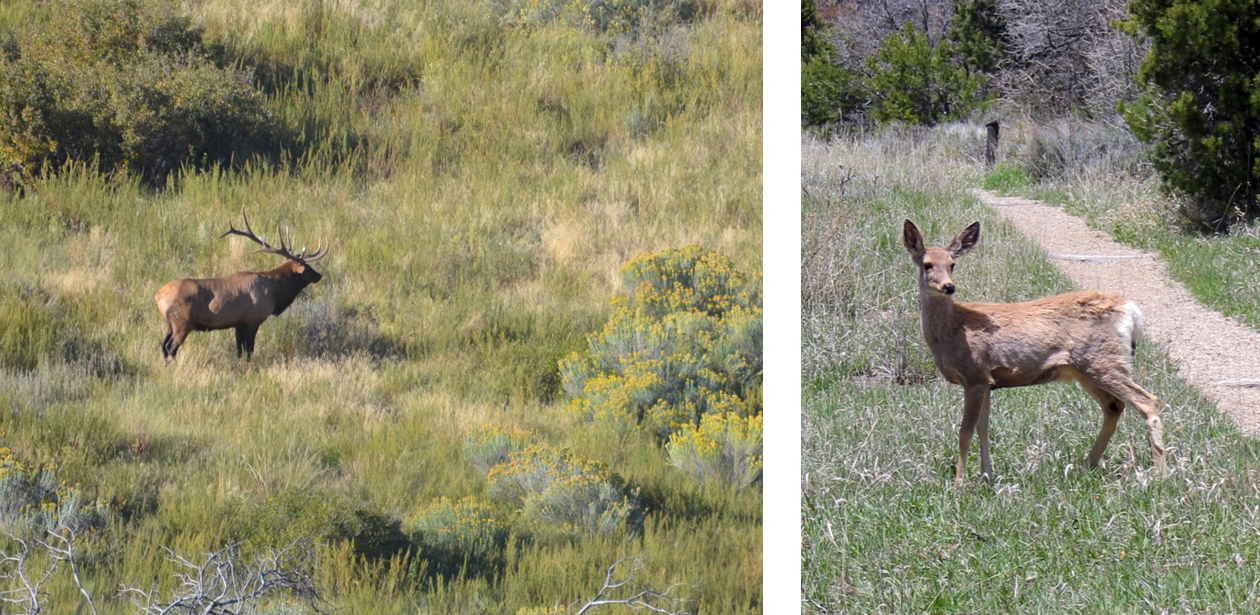Part of a series of articles titled Condition of Selected Natural Resources at Mesa Verde National Park: A 2025 Assessment.
Article
2025 Condition Assessment Findings for Elk and Mule Deer at Mesa Verde National Park
A 2025 Natural Resource Condition Assessment evaluated six natural resources at Mesa Verde National Park. This article describes what we learned about elk and deer
Two types of ungulates are found at Mesa Verde National Park (NP)—elk (Cervus elaphus) and mule deer (Odocoileus hemionus). Both species occur across the park and can be found in all habitat types. Ungulates was one of six resources included in the 2025 Natural Resource Condition Assessment (NRCA) for Mesa Verde. The NRCA team, led by Conservation Science Partners, carried out a gap analysis for elk and mule deer. A gap analysis highlights what we know and don’t know about a resource. An overview article describes the intent of the NRCA project and the other resources assessed for Mesa Verde.

NPS
A Bit about Elk and Mule Deer
Elk live in alpine, pinyon-juniper (PJ), and sagebrush habitats. Their locations change with the season and weather conditions. In the early 1900s, the elk population in the U.S. dropped to about 40,000 individuals due to unregulated hunting (Colorado Parks and Wildlife 2025). Today, thanks to management, hunting laws, and population restoration, Colorado has a much larger elk population. In fact, with about 280,000 elk reported in the mid-2020s, Colorado now has the largest elk population in the world (Colorado Parks and Wildlife 2025).
Mule deer live in a diversity of habitats in the western United States, including shrublands and a variety of forest types. Despite using a variety of habitats, mule deer populations have decreased in Colorado for decades. By 2018, Colorado Parks and Wildlife estimated that the state’s mule deer population was 433,000 individuals (Colorado Parks and Wildlife 2020). This was about 25% below the state management goal.
How did the NRCA team conduct the analysis?
For the elk and deer gap analysis, the NRCA team used herd estimates from Colorado Parks and Wildlife. These annual population estimates helped identify trends for herds using the park. The datasets for elk and mule deer spanned about 19 years, from 2004 to 2022, and were for the Data Analysis Units (DAUs) that overlap with Mesa Verde. A DAU is the geographical area that represents the year-round range of an elk or mule deer herd in a specific region.
What did the NRCA team learn?
The NRCA team found a slight increase in elk and mule deer populations over the past 20 years in DAUs that overlap the park.
The NRCA team also reported on the important connection between habitat within the park and outside the park for both elk and mule deer. Mesa Verde NP contains a small part of winter range for elk and both summer and winter range for mule deer. It also connects to portions of those ranges that extend beyond the park.
A 2019 study (Kintsch et al. 2019) found that the six miles of Highway 160, just north of Mesa Verde NP, ranked in the top 20% of Colorado's Western Slope roads needing action to reduce wildlife-vehicle collisions. In general, measures to reduce collisions include, but are not limited to, structures to accommodate wildlife movements/crossings.
What can park managers do with this information?
Information from the elk and deer analysis will help guide planning, stewardship, and management actions in the park. The NRCA team also identified remaining gaps in our knowledge. For example, the NRCA team recommended monitoring to assess elk and deer habitat use within the park, and whether more deer and elk move into the park at the beginning of the hunting season. Filling information gaps supports managers in their important responsibility of managing and preserving park resources.
References
Colorado Parks and Wildlife. 2025. Elk. Colorado Parks and Wildlife webpage. Available at https://cpw.state.co.us/species/elk (last accessed 30 May 2025).
Colorado Parks and Wildlife. 2020. Status of Colorado’s Deer, Elk, and Moose Populations, February 2020. Available at https://cpw.state.co.us/sites/default/files/2024-08/Colorado_Big_Game_Population_Status_and_Management_Summary2_2020.pdf (last accessed 02 April 2025).
Kintsch, J., P. Basting, M. McClure, and J. O. Clarke. 2019. Western slope wildlife prioritization study. Available at https://trid.trb.org/View/1959650.
Last updated: June 27, 2025
